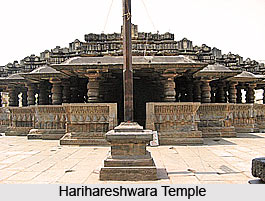 Harihareshwara Temple, an abode of Lord Vishnu, is located in Davanagere district in Harihar in the Indian state of Karnataka. The temple, known as God`s Own House, is surrounded by the enchanting hills of Harihareshwar, Harishinachal, Pushpadri and Bramhadri. The place is famous for the pristine Harihareshwar beach that draws hordes of tourists from different corners. The temple is located 539 metres above the sea level.
Harihareshwara Temple, an abode of Lord Vishnu, is located in Davanagere district in Harihar in the Indian state of Karnataka. The temple, known as God`s Own House, is surrounded by the enchanting hills of Harihareshwar, Harishinachal, Pushpadri and Bramhadri. The place is famous for the pristine Harihareshwar beach that draws hordes of tourists from different corners. The temple is located 539 metres above the sea level.
History of Harihareshwara Temple
The ancient Harihareshwara Temple, dating back to the Hoysala period, was built by a commander and minister of the Hoysala Empire King Vira Narasimha II, Polalva in 1223-1224 C.E. Later in 1268 CE few embellishments were done to the temple by Soma, a commander of King Narasimha III.
Legend of Harihareshwara Temple
A legendry allegory of the temple states about the story of a demon, Guhasura or Guha, who reined over Uchchangi Durga on the eastern side, Mudanur on the western side, Govinahalu on the southern side and Airani in the northern side. The demon had practise severe penances and mediated hard to appease Lord Brahma. The Lord blessed him with a boon that he would neither be singly killed by Hari (Vishnu) nor by Hara (Shiva). Thus, the demon began tormenting the gods and humans. Thus, to combat him Lord Shiva and Lord Vishnu took the form of Harihara and killed him. It is said that they incarnated near Kudalur.
Architecture of Harihareshwara Temple
The Harihareshwara Temple, facing the eastern side, depicts the architectural grandeur of the Hoysala period. The temple has been constructed on a square mantapa whose outer walls illustrate several projections. The half pillars that rest on the parapet wall of the mantapa provide support to the borderline of the roof. The pillars and the ceiling of the temple have been exclusively adorned with decoration such as lotuses. The edifice has been majorly built using soapstone also called potstone. The vimana over the shrine had been replaced during restoration work with mortar and brick ceilings. Several ancient Kannada inscriptions have been preserved in the temple.
The deity of Harihara installed within the temple is a fusion of two Hindu gods, the right vertical half of Lord Shiva and left vertical half of Lord Vishnu.
Presently, the temple is protected under the Ancient Monuments and Archaeological Sites and Remains Act, 1958 and is conserved and maintained by the Archaeological Survey of India.
Harihareshwara Temple can be approached by three basic modes. By road, tourists can take the Mumbai Goa highway. Local transports such as jeeps, rickshaws are available for the temple. The trains that ply on the Konkan route halt here. The Mumbai airport is the closest to Harihareshwara.





















